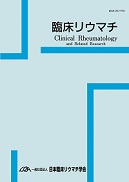20 巻, 2 号
臨床リウマチ
選択された号の論文の13件中1~13を表示しています
- |<
- <
- 1
- >
- >|
Editor's Eye
-
2008 年20 巻2 号 p. 93-94
発行日: 2008/06/30
公開日: 2016/11/30
PDF形式でダウンロード (189K)
誌説
-
2008 年20 巻2 号 p. 95-100
発行日: 2008/06/30
公開日: 2016/11/30
PDF形式でダウンロード (581K)
総説
-
2008 年20 巻2 号 p. 101-106
発行日: 2008/06/30
公開日: 2016/11/30
PDF形式でダウンロード (708K) -
2008 年20 巻2 号 p. 107-112
発行日: 2008/06/30
公開日: 2016/11/30
PDF形式でダウンロード (733K)
原著
-
2008 年20 巻2 号 p. 113-119
発行日: 2008/06/30
公開日: 2016/11/30
PDF形式でダウンロード (648K) -
2008 年20 巻2 号 p. 120-128
発行日: 2008/06/30
公開日: 2016/11/30
PDF形式でダウンロード (1627K) -
2008 年20 巻2 号 p. 129-136
発行日: 2008/06/30
公開日: 2016/11/30
PDF形式でダウンロード (344K) -
2008 年20 巻2 号 p. 137-142
発行日: 2008/06/30
公開日: 2016/11/30
PDF形式でダウンロード (379K) -
2008 年20 巻2 号 p. 143-146
発行日: 2008/06/30
公開日: 2016/11/30
PDF形式でダウンロード (621K) -
2008 年20 巻2 号 p. 147-150
発行日: 2008/06/30
公開日: 2016/11/30
PDF形式でダウンロード (443K) -
2008 年20 巻2 号 p. 151-155
発行日: 2008/06/30
公開日: 2016/11/30
PDF形式でダウンロード (919K)
臨床リウマチ医のための基礎講座
-
2008 年20 巻2 号 p. 157-159
発行日: 2008/06/30
公開日: 2016/11/30
PDF形式でダウンロード (215K)
臨床リウマチ医の広場
-
2008 年20 巻2 号 p. 160-161
発行日: 2008/06/30
公開日: 2016/11/30
PDF形式でダウンロード (171K)
- |<
- <
- 1
- >
- >|
